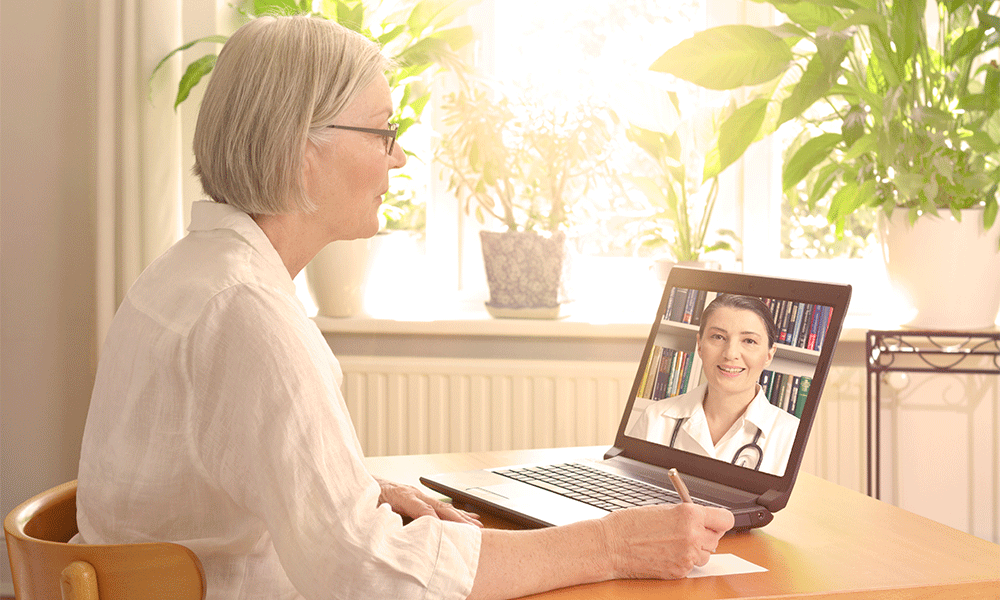How a virtual health strategy can meet patient expectations and drive practice value
Patients need to stay connected to doctors now more than ever.

Before COVID-19 hit, consumerism was already pushing the healthcare industry to adopt new technologies that modernized healthcare communications to improve the patient experience. Most independent practices and many health systems already employed some form of technology to manage their patient intake, scheduling, appointment reminders, or messaging, for example.
These tools not only help physicians, nurses, and staff work more effectively but also meet growing consumer demand for greater convenience in how patients receive care and communicate with their doctors. And believe it or not, recent surveys have found that convenience is even more important to some patients than quality of care.
These patient expectations haven’t changed in the COVID era. If anything, the global pandemic has accelerated demand for solutions-particularly video chat telehealth options-that meet patient demand for stay-at-home flexibility while allowing independent physicians to continue providing care.
Trending: 12 ways medical practice staff can help prevent a patient lawsuit
Patients Need to Stay Connected with Their Own Doctors Now More than Ever
Nationwide shelter-in-place orders and the unprecedented shutdown of the economy left many patients unsure of how to continue receiving routine care, or what they should do if they suspect they have become ill with COVID-19.
Some are continuing to go to the ER with mild symptoms or ailments, despite being asked by public officials to stay home, since they are unsure of how to connect with their doctors remotely. Yet others stay self-quarantined at home and worry about the long-term impacts of delaying routine check-ups with their physicians.
The result is a nationwide healthcare system with pockets of inefficiency. Some hospitals are overwhelmed while others are strangely empty. “Where are the strokes and the heart attacks? Where are the diabetics having complications?” said one doctor, recently. “These cases didn’t just vaporize with the virus. I worry people are suffering at home because they’re afraid our emergency rooms are radioactive.”
The need for routine care hasn’t gone away, and there’s no one better positioned than primary care physicians to offer the treatment patients need, in a safe and effective way, while preserving capacity for hospitals and emergency rooms.
For starters, primary care physicians intimately know the individual needs of their own patients. They know their medical histories and risk factors. They can more quickly triage patients who actually require emergency care, and they can effectively counsel those with less serious conditions.
Accordingly, creating regular touchpoints with patients during this time is vital. Patients want safe, familiar options available to them. Whether through phone, email, secure text messaging, video chat or otherwise, trusted primary care physicians and their staff can help alleviate anxiety, answer questions and, in general, stay connected with patients. Lives may depend on it.
Read More: Practicing social distancing in the practice and more
The Doctor is Here to See You-Virtually
Before the pandemic, many felt that telehealth wasn’t necessary or perhaps arrived before its time. Some providers held back because of reimbursement issues, perceived complexity, or cost, despite data that suggested younger patients might consider telehealth “life-changing” or “very useful” to use video chat instead of going for a routine in-person visit with their provider.
With recent regulatory and reimbursement changes, many physicians are reconsidering their position and looking for tools that meet their needs. They see other providers successfully implementing telehealth solutions as a model for their own adoption. Likewise, many have been surprised to learn that telehealth needn’t be as complicated as they feared, as second-generation options are as convenient as making a phone call - and in many cases patients actually prefer video consults to in-patient visits.
Still, before investing in a practice-changing technology, providers need to judiciously select the right solution for their needs. For example, although recent telehealth enforcement guidelines from the Department of Health and Human Services (HHS) relaxed the regulatory requirements for HIPAA compliance, healthcare providers should be wary of just any off-the-shelf video solution. Patient privacy expectations have not gone away with COVID-19, and HIPAA-compliant vendors still offer the best long-term solution for healthcare providers after the crisis has subsided.
Likewise, it may be tempting to simply choose the most convenient video app-for example, the one already on a provider’s phone, such as Apple’s FaceTime-while practices adopt non-traditional hours and remote services to handle immediate patient needs. However, while this may be convenient temporarily, it’s important to remember such an approach excludes some patients and requires sharing personal contact information. Thus, the ideal solution is one that is HIPAA compliant, works over a web browser so patients don’t have to download any new apps, and is easy to use. In this way, healthcare providers can protect both patient and physician privacy while meeting the demand for greater convenience.
Modernizing communications is just the tip of the iceberg. By developing a roadmap to leverage virtual care both now and post-COVID-19, including setting up new ways to triage patients or continuing to provide services via video or text, physicians can ultimately be more productive, engage with more patients and run a more profitable practice as a result.
While patients’ immediate needs may have changed, their short- and long-term expectations have not. While on the front lines of the pandemic, telehealth can help physicians build on their already strong patient relationships and maintain their practices during and beyond COVID. Developing a virtual health strategy now is imperative to long-term success.
Michael Morgan is the CEO at Updox. With a successful track record in helping organizations use technology to transform the way healthcare is delivered, Mike has more than 25 years of healthcare leadership within software, behavioral health, and HIT organizations. Updox was named to the Inc. 5000 list of fastest-growing companies in America for the past five consecutive years.